The first event on today’s personal agenda was the Competition Pilots’ breakfast, moderated by U.S. Contest Committee Chair Ken Sorenson. Ken presented a summary of last year’s U.S. regional and national contest participation by class as well as changes to the 2011 contest rules proposed to the SSA Board by the Rules Committee.
Last year, 382 pilots competed in 14 regional contests while 140 raced in seven nationals. The Seniors was by far the most popular, drawing 62 competitors. The Sports Class nationals took second place with 44 entrants, followed by 15 meter (30), 18 meter (29), 1-26 (12), standard (10-rained out), open (9), and World Class (6). Since 2003, the total number of contestants in all U.S. sanctioned contests has averaged about 600 per year. Attendance at nationals rose from 139 in 1997 to peak at 199 in 2002, followed by a slow but steady decline to 140 in 2010.
Ken reviewed the changes in rules proposed for 2011. The number one change is that FLARM systems will be allowed in all U.S. competitions. The scoring formula has been changed to remove the incentive for pilots to finish early in MATs and TATs. Another big change is an experiment in which multiple handicapped classes (e.g, standard + 15m, 15m + 18m) may be approved by waiver. Unlike sports class, water ballast will be allowed.
Hot topics include FLARM, the range of gliders allowed to compete in the club class, and what to do about the proliferation of inexpensive mobile phones and other devices that permit pilots to collect weather information in the cockpit and even conduct cloud flying.
Frank Paynter encouraged pilots to consider modern flight sims like Condor as part of their toolkit for maintaining and improving their racing skills. Frank flew ~350 hours last year in 11 sanctioned contests(!), but logged another 200+ on Condor in the off-season. For more information about Condor, see Frank’s articles in SoaringCafe.
[ Concurrent sessions make it impossible for one person to attend every talk, so I had to make the usual hard choices. The talks described in this and subsequent posts represent a small sample from the smorgasboard of presentations].
Speaking of Condor, at 9:00 AM, Scott Manley gave a superb presentation on how he has been using the sim as a tool for training student pilots in distant locations. For months, Scott has been providing virtual flight training via Condor to three students, two of whom he had not met in person until Wednesday! Tom and Megan Strickland, a father-daughter duo and both student pilots, were present with Scott while a third student, Craig Fulmer, participated remotely from Boston. What followed was a dramatic demonstration of how effectively pilots can be trained in basic skills of airmanship, pattern judgement, emergency procedures, and thermaling before stepping into a real glider. Everyone in the room was mightily impressed with the performance of Scott’s students and the obvious effectiveness of distance learning applied to glider flight training. I wish every instructor and student pilot could have observed this remarkable and flawless demo.
Richard Kellerman, who heads the ClearNav development team, gave a fascinating presentation on the rationale for the interface design choices that influenced the development of the ClearNav display and controls. He also described the the new vario, which is scheduled to hit the market in March. The vario will contain a three-axis accelerometer and magnetometer. The former will compensate for the transient dip in indicated climb rate during pullups caused by the increase in induced drag with increased g-loading. Dave Ellis is working on an integrated gust filter, but that capability will probably have to wait for the second (or third?) generation.
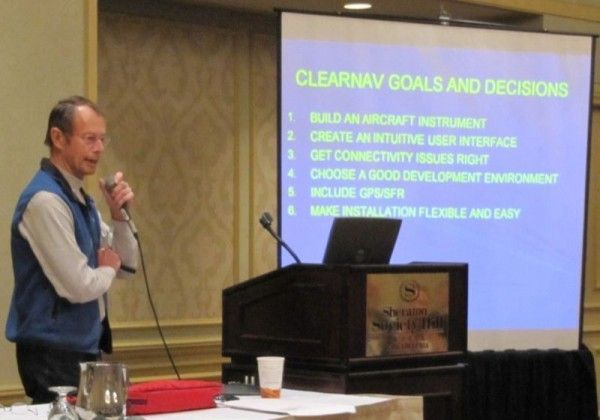
Richard Kellerman on Flight Data Development Decisions
Dave Nadler and Lee Kuhlke teamed up to lead a session about the FLARM collision avoidance system. Lee pointed out that there about 20 midairs annually in general aviation, and a third of those involve gliders. Midairs are the number two cause of accidents in gliders. There are about 15,000 FLARMs in use. Most are in gliders and the vast majority are in Europe. In 2005, there were eightreported collisions between gliders flying in the Alps. In 2006, after the wide adoption of FLARM among European pilots, there were no midairs. While those numbers aren’t proof that the introduction of FLARM was responsible for the decrease in midairs, it is certainly suggestive.
The first PowerFLARM units will arrive in the U.S. in April. About 600 have been pre-ordered by U.S. pilots. The PowerFLARM will be available as a standalone unit with an integrated display as well as a ‘brick’ containing the FLARM engine, which can be connected to a 57mm Butterfly display and a remote control. The PowerFLARM will include an ADS-B 1090ES receiver, a flight recorder (to be submitted for IGC approval), an integrated GPS antenna, and will present terrain and obstacle warnings as well as warnings when the glider is on a possible collision trajectory with another FLARM-equipped glider.
In a subsequent session, Frank Paynter presented a parametric analysis of the current and proposed U.S. contest scoring formulas, which have grown in complexity over the years until they are virtually impenetrable to most ordinary mortals. Frank’s analysis revealed some interesting anomalies that under special circumstances can affect scoring in ways not intended by the Rules Committee when the formulas were adopted. For details, click here to see Frank’s slides.
The SSA General Membership Meeting was called to order by Denise Layton, who introduced Al Tyler as our new chairman. Al proceeded to introduce Rich Carlson who spoke on behalf of the Soaring Safety Foundation, and David Pixton, who gave an accounting of SSA’s financial performance in 2010. He remarked that the sale of FAST packages produced significant revenue for the Society. In response to a question from the floor, Al promised to find out how many purchasers of FAST packages were actually staying in the SSA. The SSA staff from the Hobbs office were also recognized for their dedication and hard work.
Chairman Al recognized SSA award recipients, who were presented their awards by Awards Chair Jay Campbell and David Pixton. The most active SSA instructors in each region received awards as did several individuals who have made substantial and enduring contributions to the SSA.
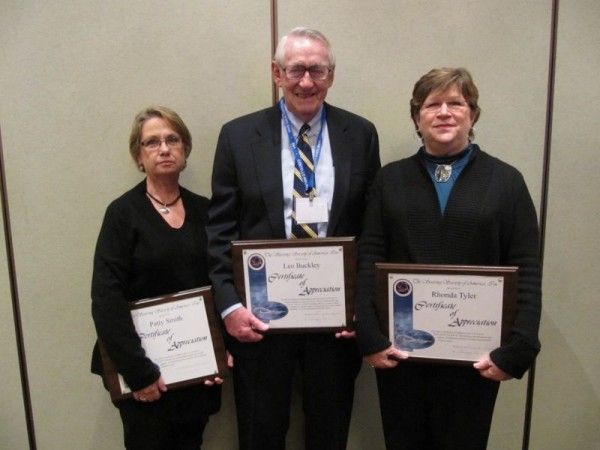
Patti Smith, Leo Buckley, and Rhonda Tyler received SSA Certificates of Appreciation
Approximately 250 persons have registered for the conference. My guess is that we’ll see an uptick on Saturday.

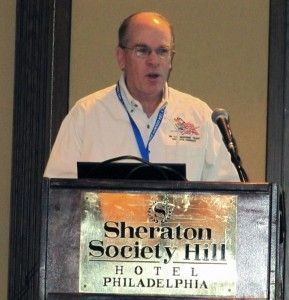
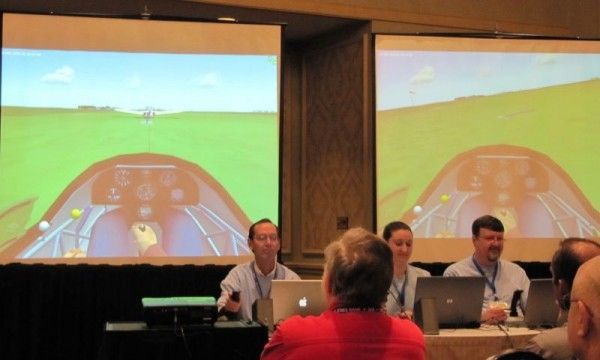
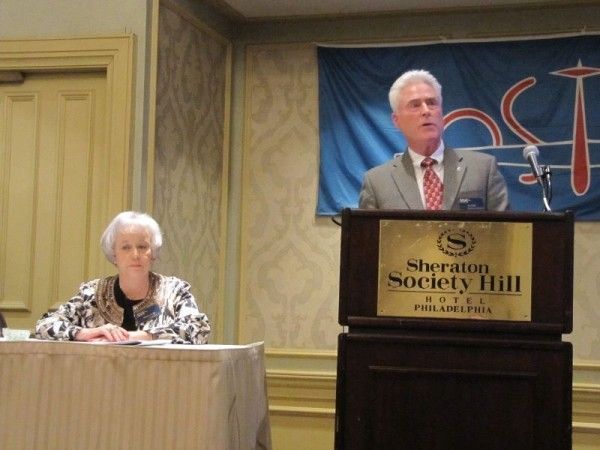






4 comments for “SSA Conference Blog – Friday”